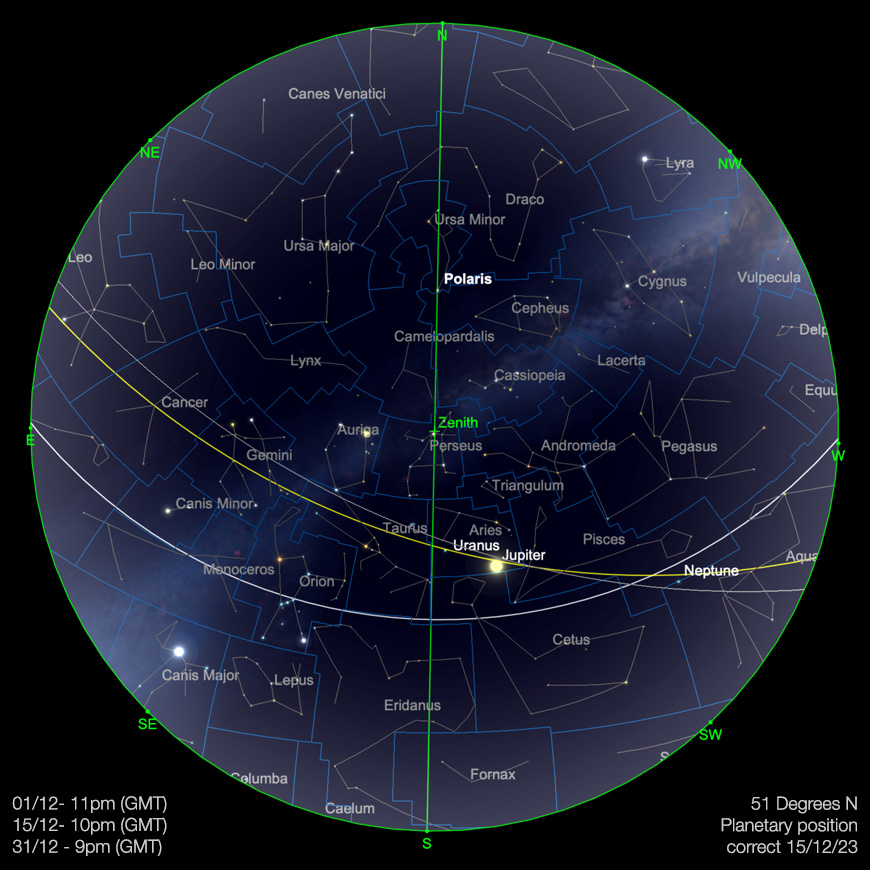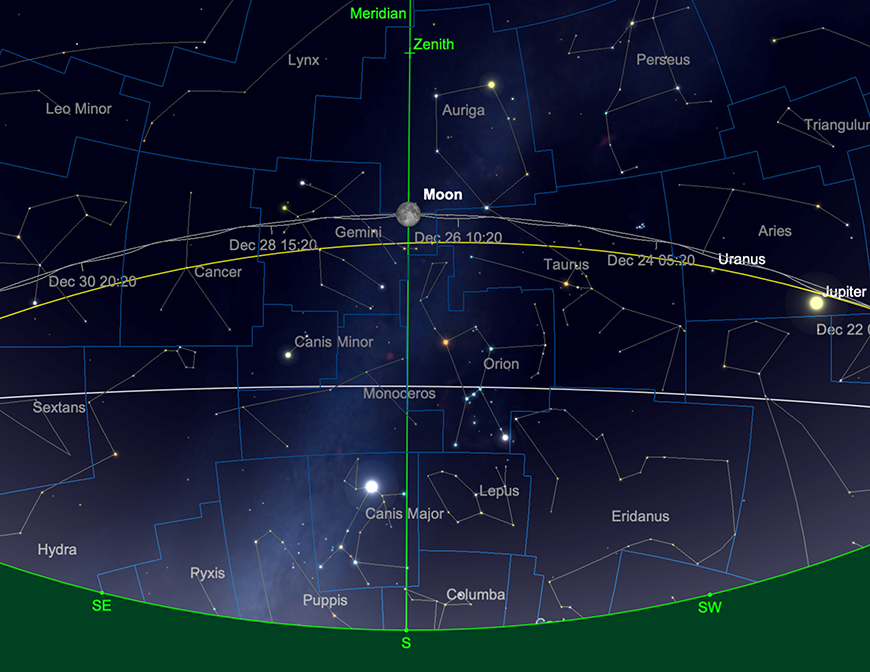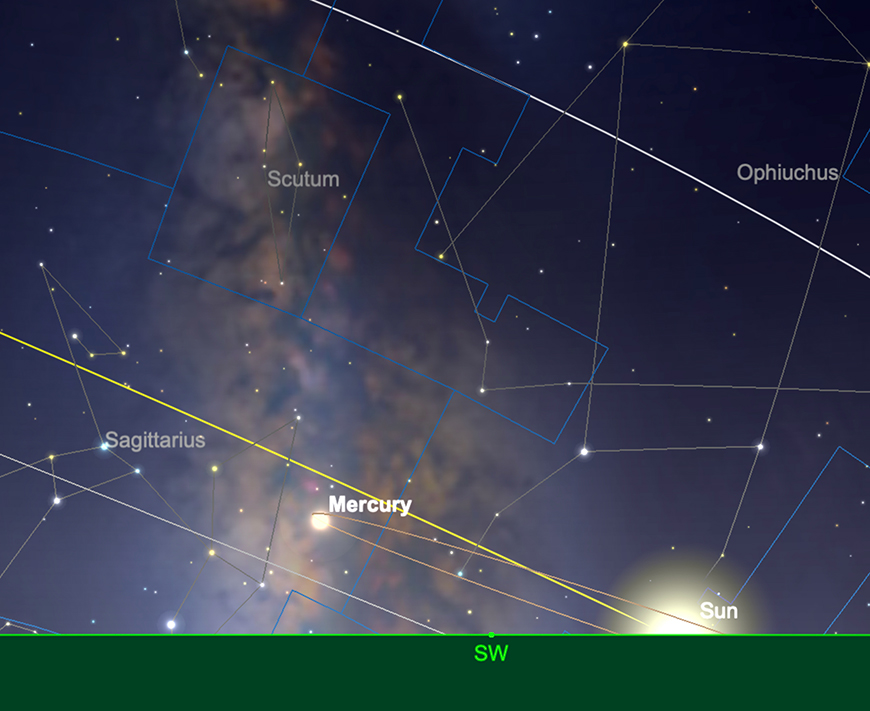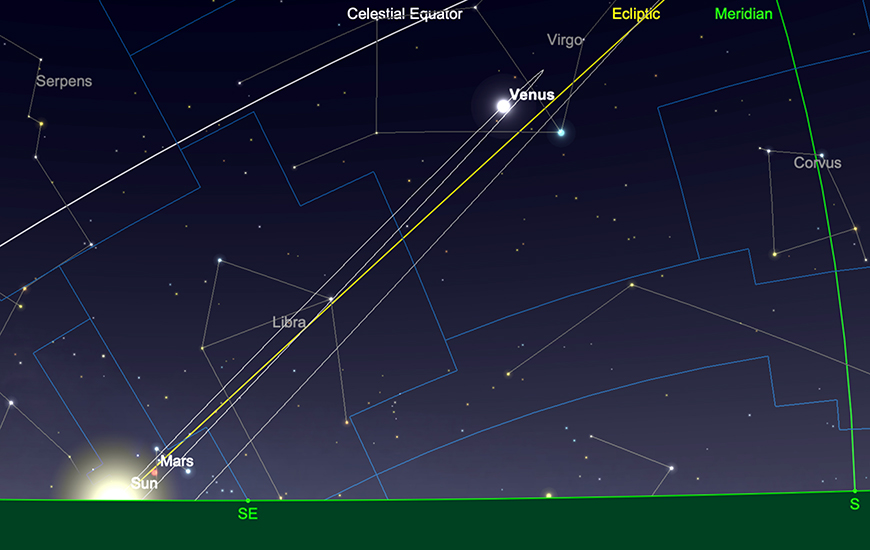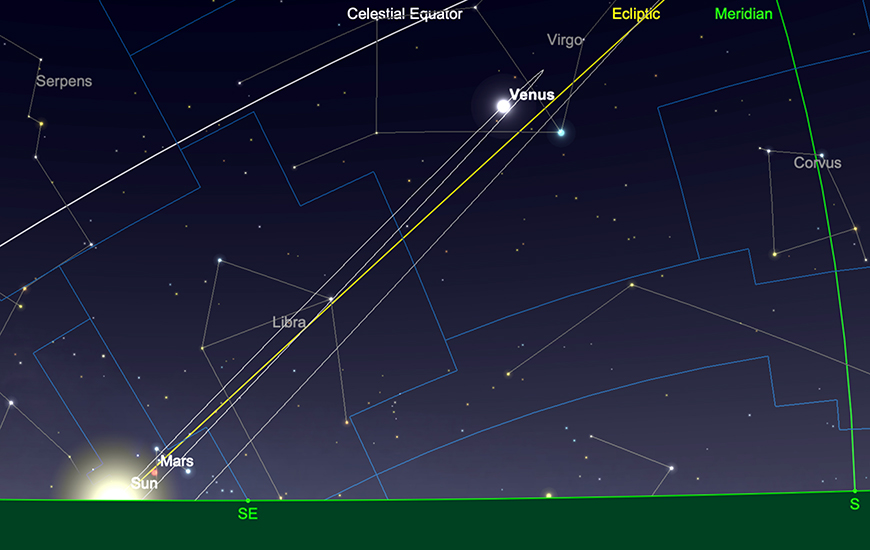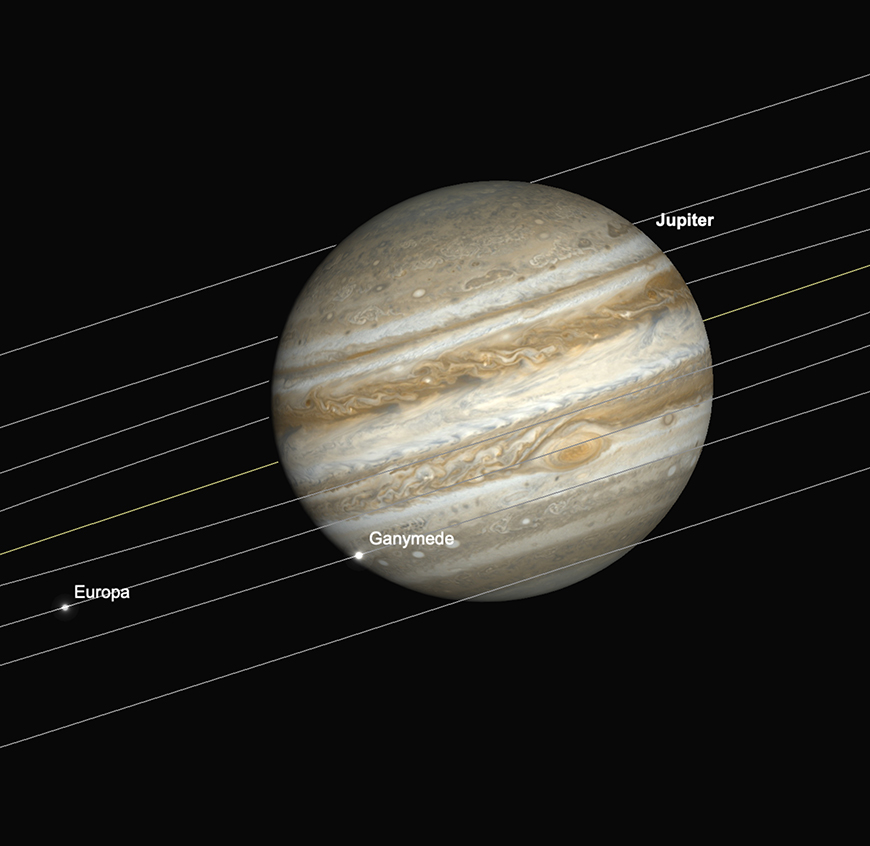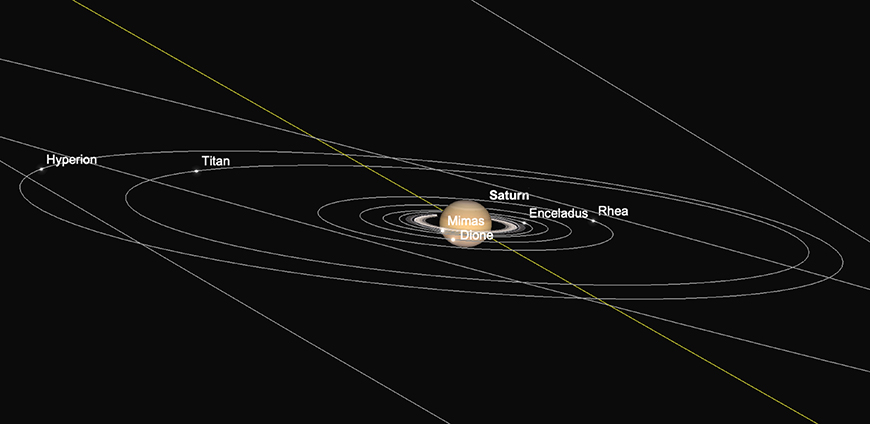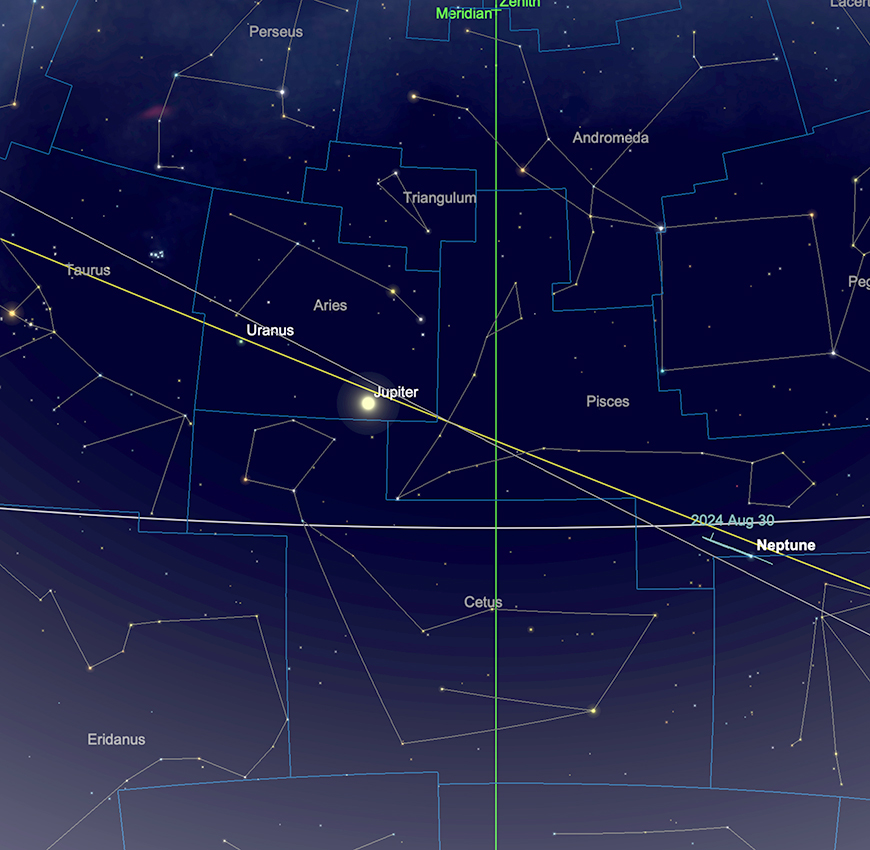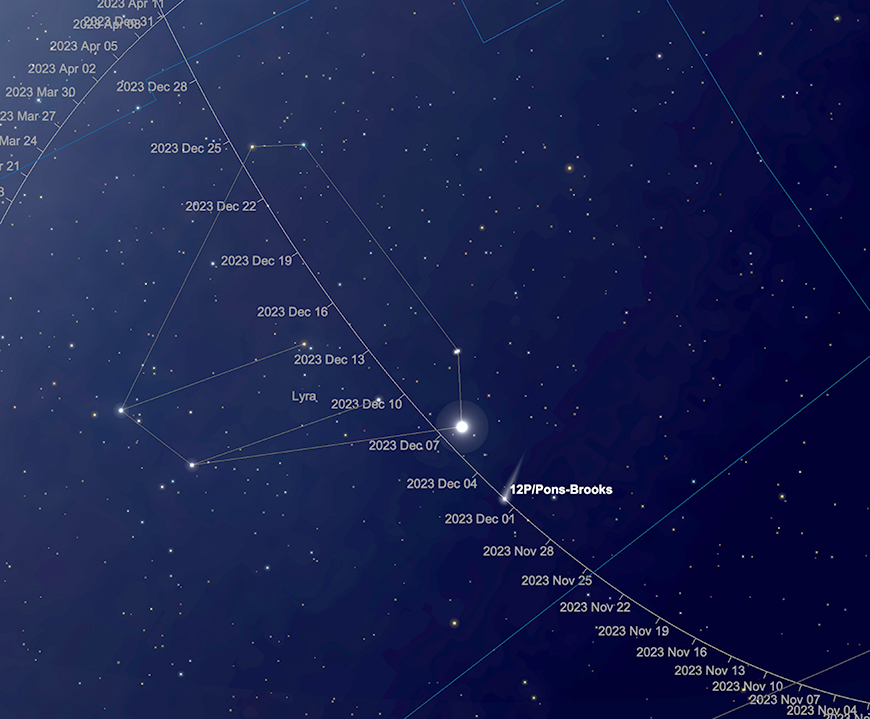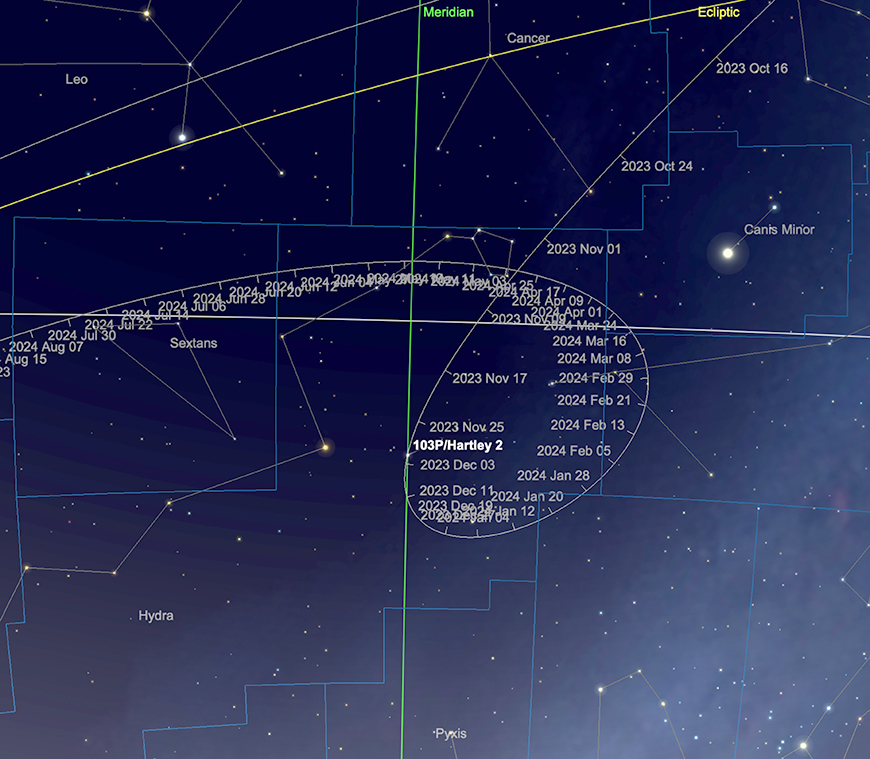It’s December and the Northern Hemisphere experiences the annual Winter Solstice on December 22nd, marking the shortest day and the longest night. As the Sun reaches its southernmost point in the ecliptic, it resides in Sagittarius, close to the borders with Ophiuchus and Scorpius. The farther north you are, the longer the Sun remains below the horizon, with around twice as many hours of darkness than sunlit hours, for those around 51° latitude. Beyond the Arctic Circle, darkness is perpetual during this time. Meanwhile, in the Southern Hemisphere, it's midsummer and residents experience their Summer Solstice.
Wherever in the world you find yourself, as ever, there’s plenty to see in the skies above us….
The Solar System
The Moon
We begin December with the Moon in the constellation of Cancer. Rising at just after 7:30 pm (GMT), the Moon will transit as a little after 3 am the following morning and set just before midday. The Moon is currently at waning gibbous phase, at around 80% illumination and while a little past full phase, will still be around for much of the night during the early part of the month. This will have naturally deleterious effects for those interested in deep sky observation and imaging at the beginning of December.
The Moon will reach last quarter phase on December 5th, where it will be a resident of Leo. After this point, the Moon will drift through the largest constellation of them all, Virgo, decreasing its phase day by day. The morning of 9th sees the very thin 14.7% illuminated crescent Moon sit side-by-side with the brilliant Venus just before dawn. The two worlds will be separated from each other by under 5° at their closest.
New Moon is reached on December 12th, when our natural satellite passes to the south of the Sun on the Scorpius/Ophiuchus borders. This point in the month is the best for those interested in deep sky observation and imaging, as the Moon is thoroughly out of the way during hours of darkness.
Past the point of New Moon, the Moon begins to rise as an evening target. It will remain pretty low in the sky for those of us in the northern hemisphere for the first few days of its evening present phase though - skirting through the southern part of the ecliptic in Sagittarius and Capricornus. The evening of 17th December, finds the Moon in reasonably close conjunction with the planet, Saturn in Aquarius. The two bodies will be separated from each other by a little under 6°, as the Sun sets.
The Moon comes to first quarter on 19th December, on the Aquarius/Pisces borders over the next few days the Moon moves through Pisces, the non-zodiacal constellation of Cetus and back into Pisces, before crossing the border into Aries, where it joins Jupiter in close conjunction on the evening of the 22nd. Jupiter and the Moon will be separated by a little under 5° in the early evening.
The Moon spends the next few days, crossing Aries and Taurus until it reaches Full on December 27th, when on the Gemini/Auriga borders. This will be the most northerly Full Moon of the year and at this time the Moon will occupy a very similar area of sky to the Sun, when at the summer solstice for the northern hemisphere. At transit point on December 27th, the Moon will stand an impressive, 67° high in the sky (as observed from 51° north). It will dominate proceedings from when it rises at just after 4 pm and will not set until nearly 9:15 the following morning. Again, this time of the month will not be the greatest for those interested in observing and imaging the fainter targets in the night sky.
The Moon spends the rest of 2023 gently rolling through Cancer and Leo, where it will end December back at waning gibbous phase at just under 85% illumination. At this point, the Moon will rise at a little before 9 pm (GMT), transit at a little after 3:30 am the following morning and set just after 11 am.
Mercury
The Solar System’s smallest planet starts December as a -0.4 magnitude target in Sagittarius. Mercury is currently moving away from the Sun as seen from our perspective here on Earth and reaches maximum easterly elongation from the Sun on the 4th of December. As the Sun is sitting in a very southerly part of the ecliptic, mercury will not attain a huge elevation above the horizon, even at its furthest point from the Sun. On the evening of the fourth Mercury will stand just over 6 1/2° elevation above the horizon (as observed from 51° north), as the Sun sets. At this point in time, Mercury will be separated from the Sun by around 21° and will remain at -0.4 magnitude, with a 62% illuminated disc of 6.7 arc seconds diameter.
As Mercury is swinging round the Sun towards us, after maximum elongation, while the planet increases in size quite dramatically, its phase also decreases in a similar dramatic way. By the middle of December, Mercury will have dimmed to +1.1 magnitude and despite displaying a healthy 8.9 arc second diameter disk, will have a narrow 19% illumination. This will make it the planet harder to spot in the glare of the evening sky. By this point in time, Mercury will be separated from the Sun by around 14° and will stand around 6°, above the horizon (as observed from 51° north).
The rest of December sees the planet arching steadily Sun-ward, decreasing in magnitude significantly as it does. Mercury will reach inferior conjunction - the position between the Earth and the Sun - on December 22, and will then re-emerge as a morning target, though it will be very late in December before it has attained significant separation from the Sun, illumination and concurrent brightness and can easily be observed again. We find Mercury on the morning of December 31st, a resident of Ophiuchus, displaying a brightness of +0.8 magnitude and an apparent size of 8.8 arc seconds. By this point in time the planet will be illuminated by just over 24%, but now being resident of a significantly steeper-rising part of the ecliptic, will have attained an elevation of just over 10° (from 51° north) above the horizon as sun rises on the 31st.
Venus
While Venus is now heading back in a Sun-ward direction after late October maximum western elongation, it is still an impressive sight in December in the morning sky. Venus appears to move at a much more sedate pace than its neighbour Mercury, so orbital changes and its relative position in the sky don’t vary by anything like Mercury’s pace. The 1st sees Venus shining at a dazzling -4.2 magnitude, displaying 17 arc second diameter disk which is illuminated by just under 68%. The planet stands at around 29° altitude (as observed from 51° north), as Sun rises.
Mid-month finds Venus, having crossed over the boundaries from the expensive Virgo, into neighbouring Libra. It has dimmed by a fractional (though visually undetectable) amount to a visual magnitude of -4.1 and now displays 15.5 arc second diameter disk illuminated by just under 73%. The planet now sits just under 24° above the horizon (again as observed from 51° north). By this point in the month, the planet is now just over 40° from the Sun.
By the end of December, not much has changed in terms of Venus’s brightness as it is still found at -4.1 magnitude. The planet now displays a 14.2 arc seconds diameter disc illuminated by just under 78%. The planet will now stand around 18 1/2° above the horizon and is separated from the Sun by just over 37 1/2°. As Venus is moving into the most southerly part of the ecliptic, as it trails behind the Sun, it is now dipping down towards the horizon and will continue to move further south with the inevitable loss of observing potential for those in the northern hemisphere, as it does. Subsequently, you encouraged to get out and observe Venus in the early part of December to make the most of optimal conditions.
Mars
Mars is emerging on the morning side of the Sun, after its recent superior conjunction and due to its current distance from us, subsequent low brightness and proximity to our parent star, is unobservable for December. This time next year Mars will be significantly brighter and in a much better part of the sky to observe, in the run-up to January 2025’s opposition. We must bide our time until then.
Jupiter
Jupiter, at just past opposition, is exceptionally well placed for observation during the entirety of December. The first finds the planet a resident of Aries, shining at a brilliant -2.8 magnitude and displaying a 49.7 arc second diameter disc. Jupiter rises in the afternoon at a little before 3 pm, and transit at a little before 10 pm on the 1st, when it will stand at just under 52° elevation, as observed from 51° north).
Mid-month will find Jupiter having faded by a tiny amount to magnitude -2.7 and will now display a 46.2 arc second diameter disc. The planet will transit at a little before 9 pm on the evening of the 15th, where it will attain an elevation of just under 52° (again as seen from 51° north).
Fast forward to the end of December and not much has changed as far as Jupiter is concerned. The planet has faded fractionally again to -2.6 magnitude and now displays of 44 arc second diameter disc Jupiter will rise at a little before 1pm and transit at a little before 8 pm.
As usual, there is much to see as far as the major moons of Jupiter and the Great Red Spot are concerned. Here are a few of the highlights for December (All times GMT):
There’s a mutual Ganymede and GRS transit starting at around 1:45 am on 2nd December.
An Io and GRS mutual transit occurs on December 8th, starting at around 5:30 pm. There’s another Io and GRS mutual transit, which starts a little before 7:30 pm on December 15th.
There’s a comparatively rare mutual transit of Callisto and the GRS, which starts at around 8:30 pm, December 17th.
A mutual transit of Europa and Ganymede starts at a little before 4:30 pm, December 23rd.
There’s a brief window of a GRS and Io/Io shadow transit event on Christmas Eve, starting at around 7 pm.
A triple event, including transits of the Great Red Spot, Ganymede and Europa, begins at around 4 pm on December 30th and concludes a few hours later.
December 31st has a Great Red Spot and Io/Io shadow transit, starting at a little after 7:30 pm.
Saturn
Saturn begins December, a resident of Aquarius, at +0.9 magnitude at this point in time. Saturn’s apparent size is just under 17 arc second diameter and the planet transits at around 5:47 pm (GMT). At transit point, Saturn will stand at an altitude of around 26 and three-quarter degrees above the horizon (as observed from 51° north). Those with access to telescopes are thoroughly recommended to make the most of Saturn's early evening apparition, as it’s only for a fairly brief window of time that we have such a spectacular target available to us at such a clement hour of the evening. As the evenings, drawing and get darker, it’s possible to observe Saturn against the truly dark background sky earlier and earlier up until the winter solstice.
By mid-December, nothing much has changed as far as Saturn is concerned - it remains at +0.9 magnitude, displaying a 16.5 arc second diameter disc. The planet will transit at a little before 5 pm and set at just before 10 pm.
By the end of December, Saturn will remain at +0.9 magnitude, though its apparent size will have shrunk a little to 16.1 arc seconds diameter. The planet will rise a little before 4 pm and set at around 9 pm (GMT). At transit point, the planet will sit at around 26° elevation (as observed from 51° north).
Uranus and Neptune
Uranus, a neighbour to the much brighter Jupiter in Aries at present, is still close to maximum magnitude, being just past opposition, which reached in mid November. The planet will display a +5.6 magnitude, 3.8 arc second diameter disc on the evening of December 1st and will rise at a little past 3 pm, transiting at just before 11 pm. As frequently mentioned in the sky guide, Uranus is technically visible with the naked eye from a very dark site, but is a much easier target to find in binoculars and telescopes. Its relative proximity to Jupiter at present, make it slightly more easy to find, with the two planets separated from each other at just over 13° at present. The evening of the 1st finds Uranus roughly halfway between Jupiter and the Pleiades star cluster in Taurus. The planet is also to be found just over 2° to the south of Botein, Delta Arietis, which is slightly brighter than Uranus, at 4th magnitude.
The more distant Neptune, is much fainter at +7.9 magnitude and displays tiny 2.3 arc second diameter disc. Neptune currently sits on the borders between Pisces and Aquarius and is solely the preserve of observation with binoculars and telescopes. Planet rises at a little before 1:30 pm on 1st and transits at 7:15 pm (GMT). While Neptune is the most distant of the “true” planets and very small, and much fainter than any of the major members of the solar system (as observed from Earth) once found it is pretty obvious that it is not a star. Sitting around 36° elevation at transit point on the first, Neptune is in an area of sky where seeing conditions dramatically improve, when compared to targets sitting lower to the horizon. As such, even though it’s a challenging target to try and find, it’s worth doing so. Those with larger instruments, experiencing good seeing conditions, have reported seeing striation across the tiny disk of Neptune when observed with high magnification. Patience is a key here, as Neptune will never be as immediate a target as Jupiter, Saturn or Venus, but it and its neighbour Uranus are still fascinating worlds in their own right and deserve their own observing attention.
Comets
C/2023 H2 is heading south and will become progressively more difficult to observe from the temperate northern hemisphere. The comet put on quite a reasonable display during mid November, peaking at an estimated sixth magnitude. However, the comet was rather large and spread out surface brightness and required telescopes and/or binoculars to observe it at all. It is receding from Earth now and southern hemisphere observers will still be able to track its progress, though the comet will be getting progressively fainter as December marches on.
Comet 12/P Pons-Brooks has undergone a couple of significant outburst events, the most recent of which being mid November. While the comet is in a particularly favourable part of the sky for observation, despite these outbursts, it is still relatively faint at around ninth magnitude. 12/P is found very close to the prominent Star Vega, Alpha Lyrae, at the beginning of December, and will pass extremely close to the Star on the evening of the 5th and 6th of December. At closest approach, the comet and Vega will be separated by around 28 arc minutes - just under half a degree. While it’s impossible to tell if further outbursts may occur, it will be interesting to monitor the progress of the comet to see if there’s any more activity.
Comet outbursts are not rare events and can sometimes be spectacular. The most spectacular of these of recent times was the 2007 outburst of 17/P Comet Holmes. This outburst caused the comet to brighten by factor of (reputedly) over 1 million times and temporarily its coma became the largest object in the solar system. While it’s unlikely that 12/P’s outbursts will be quite as spectacular, this comet is one to keep an eye on at present.
103/P Hartley will be still visible during December, but will have faded considerably from its relatively recent maximum. Expected to be around 10th or 11th magnitude, it will appear to loop round through Hydra during December, fading as it does.

 English
English

